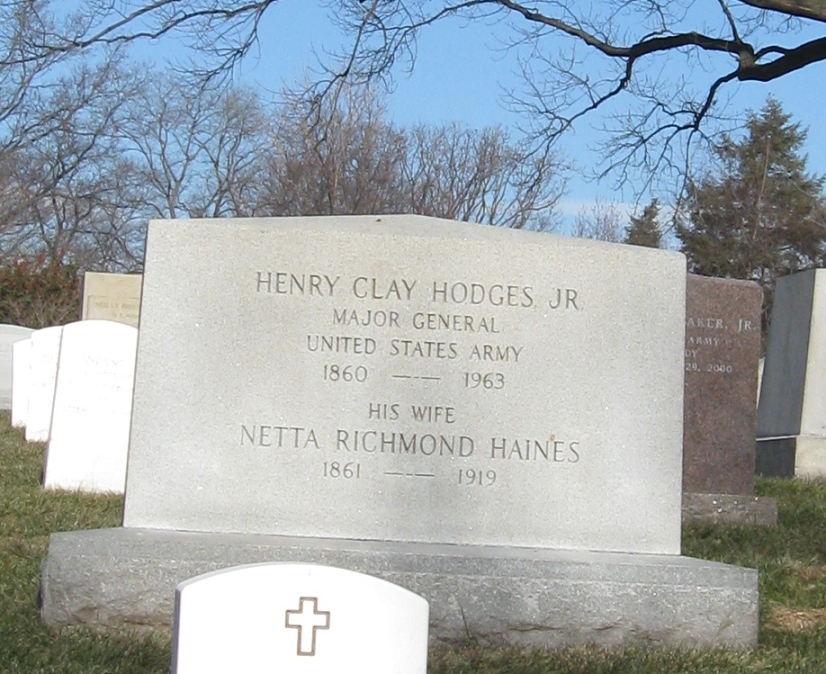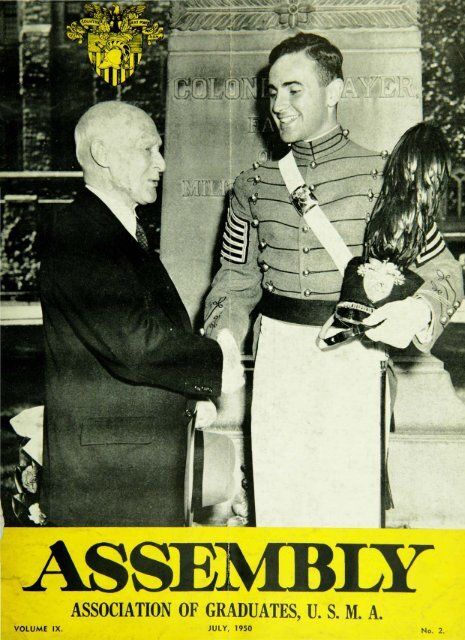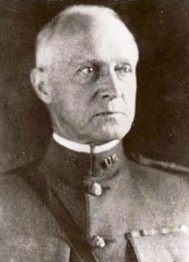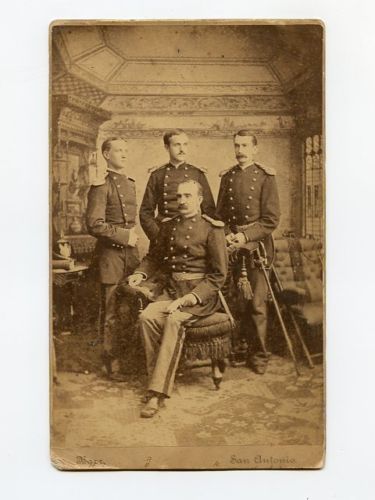Assembly, Association Of Graduates, U.S.M.A., Summer 1963
Maj. Gen. Henry Clay Hodges, USMA '81
Be Thou At Peace
Through The Years Of A Century Told
Major General Henry Clay Hodges Jr., USMA 1881, passed away in his sleep at 0730 hours July 15, 1963, at his home in Stamford, Connecticut. He was 103 years old. His devoted daughter, Evelyn, who had tenderly cared for this favorite son of West Point all during his declining years, was with him until the end.
General Hodges had been the Academy's oldest graduate since April 2, 1955 when Colonel Clarence E. Dentler, USMA 1884, passed away in Portland, Oregon, at the age of 95. General Hodges also had the distinction of being the only centenarian in the history of the Military Academy.
Henry Clay Hodges Jr., was born April 20, 1860 at Fort Vancouver (later Vancouver Barracks.) Washington Territory. His father graduated from the Military Academy in 1851 and lived to be the oldest member of his class. His mother was the former Annie Abernethy, daughter of the first elected Governor of Oregon Territory. As a typical Army brat young Hodges attended many different schools and terminated his secondary education in a boarding school at Sing Sing, now Ossining, New York, in preparation for West Point. He received his appointment from his father's very good friend, President Ulysses S. Grant, who had served with him in the Fourth Infantry in Oregon Territory years before Henry Jr. was born. Henry entered the Military Academy in June 1877, the second youngest in his class.
His nickname at West Point was Cap, a carryover from his school days in Philadelphia where he had worn a coat with brass buttons which his young classmates thought befitted a captain. Cap graduated number 23 out of 53 cadets in the Class of 1881. He was one of the most popular members of his class and earned the respect of the entire Corps of Cadets. Consideration for his fellow man continued throughout his military career and after his retirement he declined many of the privileges and honors due him on account of his age and grade because someone might be inconvenienced.
General Hodges was commissioned in the Infantry and was initially stationed with the 22d Infantry at Fort Clark, Texas. While stationed there he experienced his only brush with Indians when his regiment rounded up the Comanches who had left their reservation near the Pecos River. After serving at other frontier posts he was ordered to West Point in 1886 as an instructor in mathematics. During this tour one of his plebe students was Colonel Lewis S. Sorley, Class of 1891, now living in Washington.
General Hodges returned to frontier duty in 1891 at Fort Keogh, Montana. However, the following year he was assigned as an instructor at Groton School in Massachusetts and continued as a teacher at the New Hampshire College of Agriculture and Mechanical Arts, now the University of New Hampshire.
Following these four years of teaching he returned to frontier duty at Fort Crook, Nebraska, in 1896, during the Spanish American War. From there he was transferred to the Philippines during the Moro Insurrection and participated in eleven separate battles with the natives before being reassigned to Boston, Massachusetts and later to Newport, Rhode Island.
As a major he returned to his first love (the Infantry) in the Philippines where he served as a battalion commander before being recalled to the states as a student at the Army War College. His next assignment with the 22d Infantry in Alaska and Texas preceded his assignment to the office of the Chief of Staff where he was later assigned as Secretary of the General Staff and promoted to lieutenant colonel.
Colonel Hodges departed Washington for duty with the 17th Infantry at Eagle Pass, Texas, to help suppress the raidings of Pancho Villa. In 1916, upon his departure for the Hawaiian Department and the 1st Infantry, he was honored by the officers and men of the entire post. While in Hawaii he was promoted to brigadier general and subsequently to major general as the Army began to expand with America's entry into World War I.
He was ordered to Camp Beauregard, Louisiana, to take command of the 39th Infantry Division. When the division left Camp Beauregard for overseas, the citizens of the city of Alexandria presented him with a chest containing 200 pieces of silver engraved with his name. General Hodges took the division to France but did not get into action since the war was nearing an end and his division was deactivated to furnish replacements for other units.
Upon his return to the States he was again assigned to command Camp Beauregard and the 17th Infantry Division until it was demobilized. He reverted to his permanent rank of brigadier general after the Armistice and was again transferred to the Hawaiian Department and later to Schofield Barracks. With over 40 years of active duty General Hodges retired at his own request on December 1, 1920.
While an instructor at USMA, Hodges married Miss Netta Haines, the daughter of Thomas Jefferson Haines, USMA 1849, at Poughkeepsie on October 24, 1891. Three children were born to this marriage. Miss Evelyn Hodges, who lives in Stamford, Connecticut; Mrs. James L. Crenshaw, Bryn Mawr, Pennsylvania and a son, Parke (1902-1987), of New York City. Mrs. Hodges died in 1919.
Since his retirement General Hodges lived in Connecticut. On December 27, 1920, he married Mrs. Carrie Jones and lived in Noroton. Since her death in 1949 he lived in Stamford.
General Hodges continued his active interest in all things and most especially things concerning his beloved Alma Mater. Each year he returned to the Academy to participate in the alumni ceremonies. As the oldest graduate present, he led the Long Gray Line since 1949 in their measured step to Thayer's monument. He missed this formation only twice, each time because of illness. The Corps of Cadets was his greatest interest. On June 3d this year he made his final roll call and again, led the Long Gray Line to Thayer Monument to rededicate themselves to the West Point motto, Duty, Honor, Country.
With his passing the Military Academy and the Long Gray Line have lost a distinguished son. Quoting General Dwight D. Eisenhower: General Hodges had a distinguished career and has for many years been an inspiration for the stream of cadets who have seen in him, our oldest living graduate, an outstanding devotion to West Point and her noble motto.
Funeral services were held in the Noroton Presbyterian Church in Darien, Connecticut, on 17 July, followed by interment in Arlington National Cemetery on July 19.
With General Hodges' death, the honor of being the oldest living graduate now passes to Col. John P. Hams, USMA 1889, who will be 98 years old on August 23. Colonel Hains resides in Washington, D.C.
Assembly, Association Of Graduates, U.S.M.A., Summer 1963
Maj. Gen. Henry Clay Hodges, USMA '81
Be Thou At Peace
Through The Years Of A Century Told
Major General Henry Clay Hodges Jr., USMA 1881, passed away in his sleep at 0730 hours July 15, 1963, at his home in Stamford, Connecticut. He was 103 years old. His devoted daughter, Evelyn, who had tenderly cared for this favorite son of West Point all during his declining years, was with him until the end.
General Hodges had been the Academy's oldest graduate since April 2, 1955 when Colonel Clarence E. Dentler, USMA 1884, passed away in Portland, Oregon, at the age of 95. General Hodges also had the distinction of being the only centenarian in the history of the Military Academy.
Henry Clay Hodges Jr., was born April 20, 1860 at Fort Vancouver (later Vancouver Barracks.) Washington Territory. His father graduated from the Military Academy in 1851 and lived to be the oldest member of his class. His mother was the former Annie Abernethy, daughter of the first elected Governor of Oregon Territory. As a typical Army brat young Hodges attended many different schools and terminated his secondary education in a boarding school at Sing Sing, now Ossining, New York, in preparation for West Point. He received his appointment from his father's very good friend, President Ulysses S. Grant, who had served with him in the Fourth Infantry in Oregon Territory years before Henry Jr. was born. Henry entered the Military Academy in June 1877, the second youngest in his class.
His nickname at West Point was Cap, a carryover from his school days in Philadelphia where he had worn a coat with brass buttons which his young classmates thought befitted a captain. Cap graduated number 23 out of 53 cadets in the Class of 1881. He was one of the most popular members of his class and earned the respect of the entire Corps of Cadets. Consideration for his fellow man continued throughout his military career and after his retirement he declined many of the privileges and honors due him on account of his age and grade because someone might be inconvenienced.
General Hodges was commissioned in the Infantry and was initially stationed with the 22d Infantry at Fort Clark, Texas. While stationed there he experienced his only brush with Indians when his regiment rounded up the Comanches who had left their reservation near the Pecos River. After serving at other frontier posts he was ordered to West Point in 1886 as an instructor in mathematics. During this tour one of his plebe students was Colonel Lewis S. Sorley, Class of 1891, now living in Washington.
General Hodges returned to frontier duty in 1891 at Fort Keogh, Montana. However, the following year he was assigned as an instructor at Groton School in Massachusetts and continued as a teacher at the New Hampshire College of Agriculture and Mechanical Arts, now the University of New Hampshire.
Following these four years of teaching he returned to frontier duty at Fort Crook, Nebraska, in 1896, during the Spanish American War. From there he was transferred to the Philippines during the Moro Insurrection and participated in eleven separate battles with the natives before being reassigned to Boston, Massachusetts and later to Newport, Rhode Island.
As a major he returned to his first love (the Infantry) in the Philippines where he served as a battalion commander before being recalled to the states as a student at the Army War College. His next assignment with the 22d Infantry in Alaska and Texas preceded his assignment to the office of the Chief of Staff where he was later assigned as Secretary of the General Staff and promoted to lieutenant colonel.
Colonel Hodges departed Washington for duty with the 17th Infantry at Eagle Pass, Texas, to help suppress the raidings of Pancho Villa. In 1916, upon his departure for the Hawaiian Department and the 1st Infantry, he was honored by the officers and men of the entire post. While in Hawaii he was promoted to brigadier general and subsequently to major general as the Army began to expand with America's entry into World War I.
He was ordered to Camp Beauregard, Louisiana, to take command of the 39th Infantry Division. When the division left Camp Beauregard for overseas, the citizens of the city of Alexandria presented him with a chest containing 200 pieces of silver engraved with his name. General Hodges took the division to France but did not get into action since the war was nearing an end and his division was deactivated to furnish replacements for other units.
Upon his return to the States he was again assigned to command Camp Beauregard and the 17th Infantry Division until it was demobilized. He reverted to his permanent rank of brigadier general after the Armistice and was again transferred to the Hawaiian Department and later to Schofield Barracks. With over 40 years of active duty General Hodges retired at his own request on December 1, 1920.
While an instructor at USMA, Hodges married Miss Netta Haines, the daughter of Thomas Jefferson Haines, USMA 1849, at Poughkeepsie on October 24, 1891. Three children were born to this marriage. Miss Evelyn Hodges, who lives in Stamford, Connecticut; Mrs. James L. Crenshaw, Bryn Mawr, Pennsylvania and a son, Parke (1902-1987), of New York City. Mrs. Hodges died in 1919.
Since his retirement General Hodges lived in Connecticut. On December 27, 1920, he married Mrs. Carrie Jones and lived in Noroton. Since her death in 1949 he lived in Stamford.
General Hodges continued his active interest in all things and most especially things concerning his beloved Alma Mater. Each year he returned to the Academy to participate in the alumni ceremonies. As the oldest graduate present, he led the Long Gray Line since 1949 in their measured step to Thayer's monument. He missed this formation only twice, each time because of illness. The Corps of Cadets was his greatest interest. On June 3d this year he made his final roll call and again, led the Long Gray Line to Thayer Monument to rededicate themselves to the West Point motto, Duty, Honor, Country.
With his passing the Military Academy and the Long Gray Line have lost a distinguished son. Quoting General Dwight D. Eisenhower: General Hodges had a distinguished career and has for many years been an inspiration for the stream of cadets who have seen in him, our oldest living graduate, an outstanding devotion to West Point and her noble motto.
Funeral services were held in the Noroton Presbyterian Church in Darien, Connecticut, on 17 July, followed by interment in Arlington National Cemetery on July 19.
With General Hodges' death, the honor of being the oldest living graduate now passes to Col. John P. Hams, USMA 1889, who will be 98 years old on August 23. Colonel Hains resides in Washington, D.C.
Family Members
Sponsored by Ancestry
Advertisement
Explore more
Sponsored by Ancestry
Advertisement













